
Ad Astra’s solar power station is currently producing 96 amps @ 12V of electricity for me. This is an impressive practical delivery of over 1100 watts of power against our nominally rated 2070 watts. As a result of some missing connectors, the system has one panel not wired in, so currently the true nominal rating is 1810 watts.
What are we doing with this power?
We are doing a load of clothing in the washing machine, making 16 gallons per hour of water with our Spectra Newport 400 II water maker and charging our laptops. All the while the open circuit voltage on the house bank of batteries is at 12.9 volts and climbing in our local 11am sunlight. Earlier this morning, we were making ice with our Dometic 110v icemaker and charging the 18v lithium battery for the Makita cordless drill. We now keep the 3 kW Xantrex Inverter on all day and casually plug in anything we want – just like a house! During the night, we do not make water, ice or run the washing machine. But we still enjoy keeping our electronics charged up and as long as we made ice and water in the day we are good! The solar system has been up and running since Thursday November 10th at noon, and so far we have not had to run the generator.
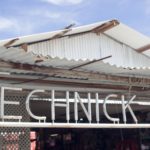
Here is where the art happened
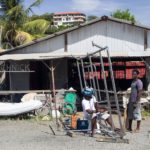
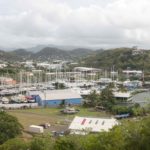
Spice Island Marina – Ad Astra at the travel lift
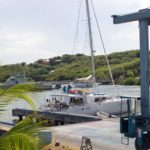
Ad Astra tied up here on the concrete for a week for the job

The topping lift and main halyard holding the top rack in place
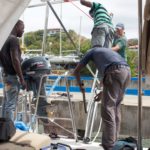
The TechNick team hard at work
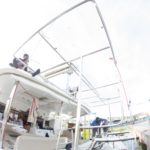
The main legs are in place
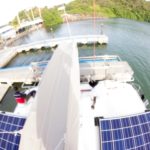
Getting there
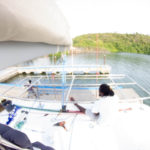
Tack welding the frame in place

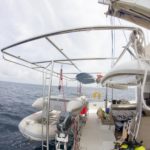
The arch is now complete – going to get our panels!
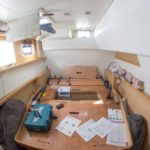
The owner’s cabin is also the main power station
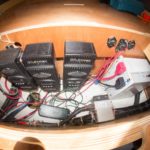
Inside peak at the three outbacks and the xantrex inveter/charger
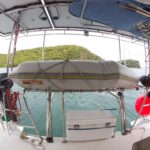
Secondary Dink Secure for Passage
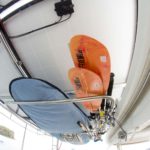
Great rack for the SUP and poles, keeps the decks clean!
What does this mean?
Previously, we would have to run the Onan 5kW diesel generator any time we wanted to make ice, water or run the washing machine. And we could only charge one laptop at a time from a small inverter. We would run the generator anywhere from 3 to 5 hours a day (split between morning and evening). The generator burns about 0.75 gallons of diesel ($6 per gallon here) an hour, and requires an oil change every 200 hours (~$50 no labor cost), and a fuel filter change (~$30 no labor cost) every 500 hours, and then unpredictable maintenance every 1000 hours or so (~$600 parts and labor). This works out to about $5.50 per hour to run the generator, and call it $20 a day, $600 a month, or $7200 we were paying for power generation. And that was considerably over budget for our planned indefinite cruising. And not modeling the labor for the generator maintenance is not realistic or pleasant. Whenever a key system such as the generator or water maker or auto pilot or engine is in a failed state all of the focus on the boat is consumed on getting that system back online. The solar setup for the most part replaces a messy, many-moving parts CO2 generating combustion engine, with a solid-state maintenance-free green power source.
What is the breakdown of the solar system we installed?
The system is actually three separate and redundant solar systems:
System 1: (2) x 255w Kyocera brand panels wired in series driven by an Outback 60 MPPT
System 2: (3) x 260w Kyocera white-label panels wired in parallel driven by an Outback 60 MPPT
System 3: (3) x 260w Kyocera white-label panels wired in parallel driven by an Outback 60 MPPT
These three Outback MPPTs are managed via a hub and a remote panel so we can see at a glance how the panels & batteries are doing.
The Super Stainless Steel Arch
To mount the six new solar panels, I sketched a stainless steel arch that I went to TechNick in Grenada to create. Over the course of 10 days with 5 guys working without a day off, they transformed my sketch into something better than I could have expected.
Here are the features of the new arch:
- An additional 300 square feet to mount the panels
- We have a new sleeping lounge area that is 7 feet long and 3 feet wide that flies over the dinghy davits and water and shaded by the panels.For passage-making it acts as an excellent place to store our smaller tender.
- We have a rack for the SUP that easily accommodates the dozen or so pole-like tools (fishing, boat hooks, fishing net & gaff, brooms and brushes)
- A 2:1 lifting pulley system for lifting the outboard engine or other heavy gear
- A BBQ area
- A place to store the huge red fender buoys
- And a permanent mount for our 100 quart Igloo ice-box that serves as an auxiliary locker most of the time and a step up to the new lounging area.
It is a freakin’ 2-dinghy garage for Ad Astra!
What is left to do?
We need to wire up that 6th panel in Bequia. But as can be seen now, Ad Astra has a healthy amount of redundancy in these systems. She could lose 1/3rd of the panels / controllers and still have all of our comforts with careful planning of the day’s power. She could lose 2/3rds and we would have to cut down on some of the luxuries and/or at the very least plan them very well.
I still have a lot of concern about the health of our Lifeline AGM house bank with 1050 Ah nominal capacity, but even with its questionable state we make it to the morning at about 12.3v open circuit and then the sun comes up and by even 9am the house is approaching 12.9v. With multiple days of extended rain we would still need to start up the generator and/or use the engines and their twin 80 Amp alternators.
With the huge amount of solar, the next time we buy a new set of batteries, we will not likely need to buy another for 12 years by virtue of taking them back to 100% state of charge every day – most of the day. And if we bought Lithium batteries we might just be done.
Post navigation